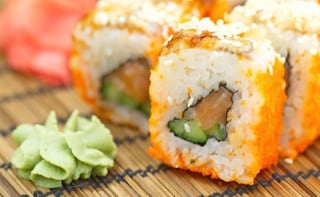Say wasabi, and most people will remember it as an accompaniment to sushi. But the first thought that comes to my mind when someone refers to this prized Japanese ingredient is wasabi coated green peas. Surprisingly, it has become a favourite snack among my friends, with the amusement of watching each other freeze for a few seconds when the characteristic pungency stings through the nasal passage bringing tears to the eyes. Oh yes, those peas are incredibly potent, and quite nasty, might I add. Yet, they are so addictive that it is hard to stop munching. Unlike chillies, the burning sensation is short spanned, which probably is the reason why we enjoy them so much. Small thrills in life!
The Prized StemWasabi is often mistaken to be horseradish. Although it belongs to the same family – Brassicaceae, which also includes mustard, it is very different from its cousins. The plant is native to Japan and grows naturally along the river bed in the mountains. The condiment is prepared using the stems, with the help of a traditional tool made of sharkskin to grate them. While the toothpaste resembling tubes containing wasabi paste or wasabi powder are commonly available commercially, the locals in Japan enjoy the privilege of picking fresh wasabi stems from the vegetable markets.
Recipe by Chef Nikhil ChibThe best cuisines in the world are based on two elements: nature and harmony. Rustle up this fusion 'Wasabi Aloo Tikki' by marrying Japanese and Indian flavours.
For the recipe, click here.
Recipe by Chefs Nikhil and NatashaThis French classic gets an Asian twist with the use of wasabi. Nikhil and Natasha stir up a delightful yet simple broccoli soup that is perfect for winters.
For the recipe, click here.
Recipe by Chef Joey MathewChicken legs cooked with spicy pork sausage and served with beans dressed in wasabi mayonnaise on the side.
For the recipe, click here.
The Prized StemWasabi is often mistaken to be horseradish. Although it belongs to the same family – Brassicaceae, which also includes mustard, it is very different from its cousins. The plant is native to Japan and grows naturally along the river bed in the mountains. The condiment is prepared using the stems, with the help of a traditional tool made of sharkskin to grate them. While the toothpaste resembling tubes containing wasabi paste or wasabi powder are commonly available commercially, the locals in Japan enjoy the privilege of picking fresh wasabi stems from the vegetable markets.
Advertisement
Advertisement
Recipe by Chef Nikhil ChibThe best cuisines in the world are based on two elements: nature and harmony. Rustle up this fusion 'Wasabi Aloo Tikki' by marrying Japanese and Indian flavours.
For the recipe, click here.
Advertisement
Recipe by Chefs Nikhil and NatashaThis French classic gets an Asian twist with the use of wasabi. Nikhil and Natasha stir up a delightful yet simple broccoli soup that is perfect for winters.
For the recipe, click here.
Recipe by Chef Joey MathewChicken legs cooked with spicy pork sausage and served with beans dressed in wasabi mayonnaise on the side.
For the recipe, click here.
For the latest food news, health tips and recipes, like us on Facebook or follow us on Twitter and YouTube.
Advertisement
